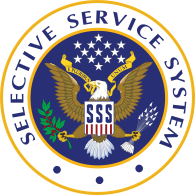Selective service
 |
|
| Agency overview | |
|---|---|
| Formed | May 18, 1917 |
| Headquarters | Arlington County, Virginia, U.S. |
| Employees | (2008): 136 full-time civilians, 57 part-time civilian directors, 200 part-time reserve force officers (in peacetime), up to 10,830 part-time volunteers |
| Annual budget | $24 million (FY 2012) |
| Agency executive |
|
| Website | www |
The Selective Service System is an independent agency of the United States government that maintains information on those potentially subject to military conscription. Virtually all male U.S. citizens and male immigrant non-citizens between the ages of 18 and 25 are required by law to have registered within 30 days of their 18th birthdays and must notify Selective Service within ten days of any changes to any of the information they provided on their registration cards, like a change of address. A 2010 GAO report estimated the registration rate at 92% with the names and addresses of over 16.2 million men on file. However, the only audit of the addresses of registrants on file with the Selective Service System, in 1982, found that 20–40% of the addresses on file with the Selective Service System for registrants in the age groups that would be drafted first were already outdated, and up to 75% for those registrants in their last year of potential eligibility to be drafted would be invalid.
Registration with Selective Service is also required for various federal programs and benefits, including Federal Student Financial Aid (FAFSA), such as (student loans) and Pell Grant, job training, federal employment, and naturalization.
The Selective Service System provides the names of all registrants to the Joint Advertising Marketing Research & Studies (JAMRS) program for inclusion in the JAMRS Consolidated Recruitment Database. The names are distributed to the Services for recruiting purposes on a quarterly basis.
Regulations are codified at 32 C.F.R. 1600–1699 (Chapter XVI).
Owing to very slow enlistment following the U.S. declaration of war against Germany on April 6, the Selective Service Act of 1917 (40 Stat. 76) was passed by the 65th United States Congress on May 18, 1917, creating the Selective Service System to raise an army to fight in Europe. The Act gave the President the power to conscript men for military service. All men aged 21 to 30 were required to register for military service for a service period of 12 months. As of mid-November 1917, all registrants were placed in one of five new classifications. Men in Class I were the first to be drafted, and men in lower classifications were deferred. Dependency deferments for registrants who were fathers or husbands were especially widespread. The age limit was later raised in August 1918 to a maximum age of 45. The military draft was discontinued in 1920.
...
Wikipedia
